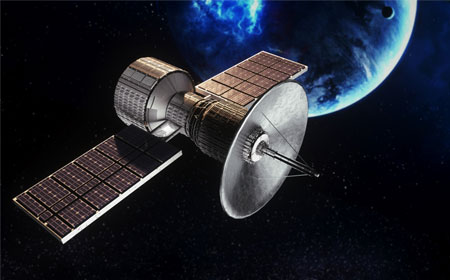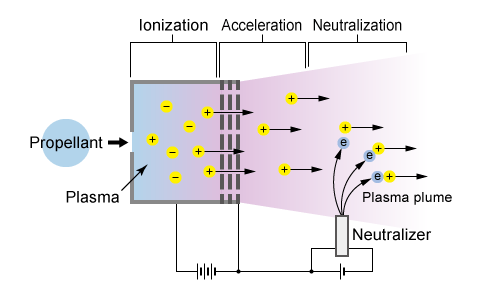Ion engines are also referred to as ion thrusters, ion drives, or ion propulsion systems. In Japan, this technology garnered significant attention for its pivotal role in the Hayabusa2 asteroid explorer mission. Although they do not produce high thrust, their efficiency in converting fuel energy into sustained propulsion makes them an essential technology for deep space exploration. This article outlines the fundamental principles, mechanism, structure, and applications of ion engines.

What is an Ion Engine?
An ion engine is a type of electrostatic propulsion system that generates thrust by electrostatically accelerating plasma (a state of ionized gas). They are mainly used to provide propulsion for space probes and satellites.
The propulsion system of spacecraft, such as space probes and satellites, fundamentally operates on Newton's third law (action-reaction principle), generating thrust by expelling mass (e.g., gas) at high velocity. The speed of this expulsion is called the exhaust velocity.
Spacecraft propulsion systems can be broadly classified into two types: chemical propulsion systems (chemical rockets) and electric propulsion systems. A chemical propulsion system obtains propulsion by combustion, a type of chemical reaction. While chemical propulsion systems have very high thrust, they are characterized by low specific impulse, which corresponds to the fuel consumption of the engine.
Specific impulse (Isp) is a measure of engine efficiency, representing the duration (in seconds) for which one kilogram of propellant can produce one kilogram-force (kgf) of thrust (or alternatively, the total impulse per unit of propellant consumed, often expressed in meters per second). Typically, chemical propulsion systems using solid fuels exhibit a specific impulse of around 300 seconds, while those employing liquid fuels achieve approximately 500 seconds. In stark contrast, ion engines can attain specific impulses ranging from 2,500 to 4,000 seconds, or even higher in some designs.
Chemical propulsion systems have low specific impulse but very high thrust, so they are also used for launching satellites and space shuttles.
An electric propulsion system is an engine that uses electrical energy to heat or accelerate propellant and exhaust it to obtain thrust. Although it has less thrust than chemical propulsion systems, it can go longer with less fuel because of its higher specific impulse.
This makes it possible to reach distant destinations and is used for deep space exploration and satellite orbit correction.
The ion engine is a type of electric propulsion system. Consequently, ion engines can achieve exhaust velocities approximately 10 times greater than those of conventional chemical rockets.
Ion engine mechanism and structure
The ion engine first turns the fuel into plasma and extracts only ions from it. The mechanism is to accelerate those ions to obtain thrust. Therefore, the ion engine consists of three main areas.
• Ionization
This section is responsible for ionizing the propellant (typically a noble gas like xenon) to create a plasma containing positive ions and electrons. The propellant is converted into plasma through methods such as DC discharge, radio frequency (RF) inductive coupling, or microwave electron cyclotron resonance (ECR). There are three types of plasma generation methods: DC discharge, RF (Radio Frequency) induced discharge, and microwave discharge.
The microwave discharge type does not require electrodes and is not limited by their life span. It also has features such as no need for protection against atmospheric exposure when testing on the ground. Furthermore, no special procedures or additional equipment are required for plasma ignition, simplifying and extending the life of the entire ion propulsion system.
• Acceleration
Here, the positive ions generated in the ionization stage are electrostatically accelerated to high velocities to produce thrust.
This is typically achieved using a set of two or three precisely aligned grids with thousands of apertures, across which a high voltage potential (several hundred to over 1000 volts) is applied. This potential difference draws out and accelerates only the ions in the plasma.
• Neutralization
Since only positive ions are expelled to generate thrust, the spacecraft would rapidly accumulate a negative electrical charge if this process were uncompensated. This charge imbalance would eventually attract the expelled ions back to the spacecraft, neutralizing the thrust and potentially damaging components.
To prevent this, a neutralizer (electron gun) expels an equal amount of electrons, thereby maintaining the spacecraft's electrical neutrality and ensuring continuous thrust generation. This prevents the satellite from becoming electrically charged and allows the engine to continue generating propulsion.

Ion engine features
Ion engine features include the following
- High specific impulse
- Can be operated for extended periods of time.
This longevity is particularly vital for deep space exploration missions, which often involve spacecraft journeying for multiple years. Therefore, the operating time of the spacecraft's engines can reach 10,000 hours. In other words, it is necessary to obtain propulsive power for a long time with less fuel.
Conventional chemical rockets, commonly used for satellite launches, are less suitable for extended deep space missions because a large fraction of their launch mass must be dedicated to propellant. This requires engines like ion engines that have high specific impulse and can run for long periods of time on little fuel.
In addition, although ion engines have lower thrust, when operated for extended periods, their final velocity in space can exceed that of chemical propulsion rockets.
On the other hand, ion engines can only operate in a vacuum and thus cannot be used for launches from Earth. They are used primarily in space.
Ion engine applications
Ion engines were originally developed for space exploration. Therefore, it is basically installed on spacecraft and used as the main propulsion system for satellite orbit correction and space probes.
The first successful in-space operational test of an ion engine was conducted aboard NASA's Space Electric Rocket Test I (SERT I) mission in 1964. It has since been used in the space probes Hayabusa, SMART-1, and Hayabusa-2, as well as the satellite Kiku No. 8.
In recent years, commercial communication satellites and nano-satellites have also been equipped with ion engines.
Reference
- JAXA 「イオンエンジンの可能性にかけて」
(https://www.jaxa.jp/article/special/hayabusa/kuninaka_j.html) - NEC 「はやぶさ2 イオンエンジンと今後の展望」
(https://jpn.nec.com/techrep/journal/g21/n01/210127.html) - 九州大学総合理工学府先端エネルギー理工学専攻山本研究室
http://art.aees.kyushu-u.ac.jp/research/elec/Ion/principle.html (non-https address) - WIKIPEDIA: SERT-1 was the first spacecraft to utilize ion engine design.
(https://en.wikipedia.org/wiki/SERT-1)


